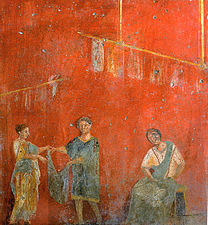
Red
Red is the color at the long wavelength end of the visible spectrum of light, next to orange and opposite violet. It has a dominant wavelength of approximately 625–740 nanometres.[1] It is a primary color in the RGB color model and a secondary color (made from magenta and yellow) in the CMYK color model, and is the complementary color of cyan. Reds range from the brilliant yellow-tinged scarlet and vermillion to bluish-red crimson, and vary in shade from the pale red pink to the dark red burgundy.[2]
This article is about the color. For other uses, see Red (disambiguation).
Red pigment made from ochre was one of the first colors used in prehistoric art. The Ancient Egyptians and Mayans colored their faces red in ceremonies; Roman generals had their bodies colored red to celebrate victories. It was also an important color in China, where it was used to color early pottery and later the gates and walls of palaces.[3]: 60–61 In the Renaissance, the brilliant red costumes for the nobility and wealthy were dyed with kermes and cochineal. The 19th century brought the introduction of the first synthetic red dyes, which replaced the traditional dyes. Red became a symbolic color of communism and socialism; Soviet Russia adopted a red flag following the Bolshevik Revolution in 1917. The Soviet red banner would subsequently be used throughout the entire history of the Soviet Union, starting from 1922 and ending with its 1991 dissolution. China adopted its own red flag following the Chinese Communist Revolution. A red flag was also adopted by North Vietnam in 1954, and by all of Vietnam in 1975.
Since red is the color of blood, it has historically been associated with sacrifice, danger, and courage. Modern surveys in Europe and the United States show red is also the color most commonly associated with heat, activity, passion, sexuality, anger, love, and joy. In China, India, and many other Asian countries it is the color symbolizing happiness and good fortune.[4]: 39–63
Symbolism
Courage and sacrifice
Surveys show that red is the color most associated with courage.[4]: 43 In western countries red is a symbol of martyrs and sacrifice, particularly because of its association with blood.[57] Beginning in the Middle Ages, the Pope and Cardinals of the Roman Catholic Church wore red to symbolize the blood of Christ and the Christian martyrs. The banner of the Christian soldiers in the First Crusade was a red cross on a white field, the St. George's Cross. According to Christian tradition, Saint George was a Roman soldier who was a member of the guards of the Emperor Diocletian, who refused to renounce his Christian faith and was martyred. The Saint George's Cross became the Flag of England in the 16th century, and now is part of the Union Flag of the United Kingdom, as well as the Flag of the Republic of Georgia.[53]: 36
The first known team sport to feature red uniforms was chariot racing during the late Roman Empire. The earliest races were between two chariots, one driver wearing red, the other white. Later, the number of teams was increased to four, including drivers in light green and sky blue. Twenty-five races were run in a day, with a total of one hundred chariots participating.[90]
Today many sports teams throughout the world feature red on their uniforms. Along with blue, red is the most commonly used non-white color in sports. Numerous national sports teams wear red, often through association with their national flags. A few of these teams feature the color as part of their nickname such as Spain (with their association football (soccer) national team nicknamed La Furia Roja or "The Red Fury") and Belgium (whose football team bears the nickname Rode Duivels or "Red Devils").
In club association football (soccer), red is a commonly used color throughout the world. Among European notable club teams most often playing at home in red shirts include Bayern Munich, Benfica, Liverpool, Manchester United and Roma. Furthermore, many prominent teams play in partially red color schemes, involving different-colored sleeves or stripes. A number of teams' nicknames feature the color. A red penalty card is issued to a player who commits a serious infraction: the player is immediately disqualified from further play and his team must continue with one fewer player for the game's duration.
Rosso Corsa is the red international motor racing color of cars entered by teams from Italy. Since the 1920s Italian race cars of Alfa Romeo, Maserati, Lancia, and later Ferrari and Abarth have been painted with a color known as rosso corsa ("racing red"). National colors were mostly replaced in Formula One by commercial sponsor liveries in 1968, but unlike most other teams, Ferrari always kept the traditional red, although the shade of the color varies. Ducati traditionally run red factory bikes in motorcycle World Championship racing.
The color is commonly used for professional sports teams in Canada and the United States with eleven Major League Baseball teams, eleven National Hockey League teams, seven National Football League teams and eleven National Basketball Association teams prominently featuring some shade of the color. The color is also featured in the league logos of Major League Baseball, the National Football League and the National Basketball Association.[91] In the National Football League, a red flag is thrown by the head coach to challenge a referee's decision during the game. During the 1950s when red was strongly associated with communism in the United States, the modern Cincinnati Reds team was known as the "Redlegs" and the term was used on baseball cards. After the red scare faded, the team was known as the "Reds" again.[92]
In boxing, red is often the color used on a fighter's gloves. George Foreman wore the same red trunks he used during his loss to Muhammad Ali when he defeated Michael Moorer 20 years later to regain the title he lost. Boxers named or nicknamed "red" include Red Burman, Ernie "Red" Lopez, and his brother Danny "Little Red" Lopez.
Red is the most common color found in national flags, found on the flags of 77 percent of the 210 countries listed as independent in 2016; far ahead of white (58 percent); green (40 percent) and blue (37 percent).[93] The British flag bears the colors red, white and blue; it includes the cross of Saint George, patron saint of England, and the saltire of Saint Patrick, patron saint of Ireland, both of which are red on white.[94]: 10 The flag of the United States bears the colors of Britain,[95] the colors of the French tricolore include red as part of the old Paris coat of arms, and other countries' flags, such as those of Australia, New Zealand, and Fiji, carry a small inset of the British flag in memory of their ties to that country.[94]: 13–20 Many former colonies of Spain, such as Mexico, Colombia, Costa Rica, Cuba, Ecuador, Panama, Peru, Puerto Rico and Venezuela, also feature red-one of the colors of the Spanish flag-on their own banners. Red flags are also used to symbolize storms, bad water conditions, and many other dangers.
The red on the flag of Nepal represents the floral emblem of the country, the rhododendron.
Red, blue, and white are also the Pan-Slavic colors adopted by the Slavic solidarity movement of the late nineteenth century. Initially these were the colors of the Russian flag; as the Slavic movement grew, they were adopted by other Slavic peoples including Slovaks, Slovenes, and Serbs. The flags of the Czech Republic and Poland use red for historic heraldic reasons (see Coat of arms of Poland and Coat of arms of the Czech Republic) & not due to Pan-Slavic connotations. In 2004 Georgia adopted a new white flag, which consists of four small and one big red cross in the middle touching all four sides.
Red, white, and black were the colors of the German Empire from 1870 to 1918, and as such they came to be associated with German nationalism. In the 1920s they were adopted as the colors of the Nazi flag. In Mein Kampf, Hitler explained that they were "revered colors expressive of our homage to the glorious past." The red part of the flag was also chosen to attract attention – Hitler wrote: "the new flag ... should prove effective as a large poster" because "in hundreds of thousands of cases a really striking emblem may be the first cause of awakening interest in a movement." The red also symbolized the social program of the Nazis, aimed at German workers.[96] Several designs by a number of different authors were considered, but the one adopted in the end was Hitler's personal design.[97]
Red, white, green and black are the colors of Pan-Arabism and are used by many Arab countries.[98]
Red, gold, green, and black are the colors of Pan-Africanism. Several African countries thus use the color on their flags, including South Africa, Ghana, Senegal, Mali, Ethiopia, Togo, Guinea, Benin, and Zimbabwe. The Pan-African colors are borrowed from the flag of Ethiopia, one of the oldest independent African countries.[98][99] Rwanda, notably, removed red from its flag after the Rwandan genocide because of red's association with blood.[100]
The flags of Japan and Bangladesh both have a red circle in the middle of different colored backgrounds. The flag of the Philippines has a red trapezoid on the bottom signifying blood, courage, and valor (also, if the flag is inverted so that the red trapezoid is on top and the blue at the bottom, it indicates a state of war). The flag of Singapore has a red rectangle on the top. The field of the flag of Portugal is green and red. The Ottoman Empire adopted several different red flags during the six centuries of its rule, with the successor Republic of Turkey continuing the 1844 Ottoman flag.
Social and special interest groups
Such names as Red Club (a bar), Red Carpet (a discothèque) or Red Cottbus and Club Red (event locations) suggest liveliness and excitement. The Red Hat Society is a social group founded in 1998 for women 50 and over. Use of the color red to call attention to an emergency situation is evident in the names of such organizations as the Red Cross (humanitarian aid), Red Hot Organization (AIDS support), and the Red List of Threatened Species (of IUCN). In reference to humans, term "red" is often used in the West to describe the indigenous peoples of the Americas.[107]
Many idiomatic expressions exploit the various connotations of red:




















